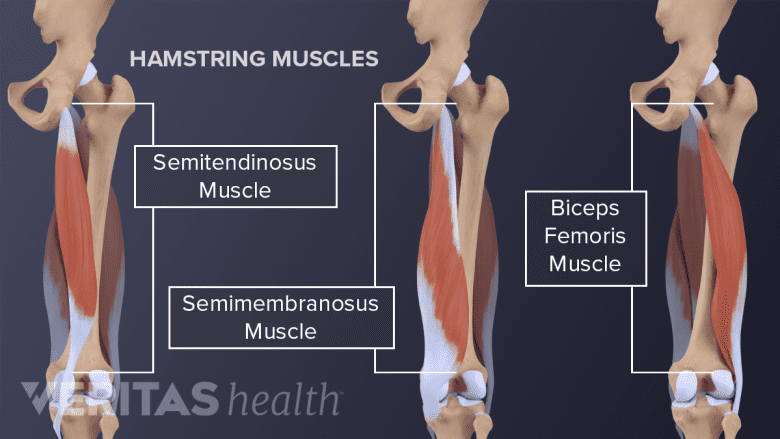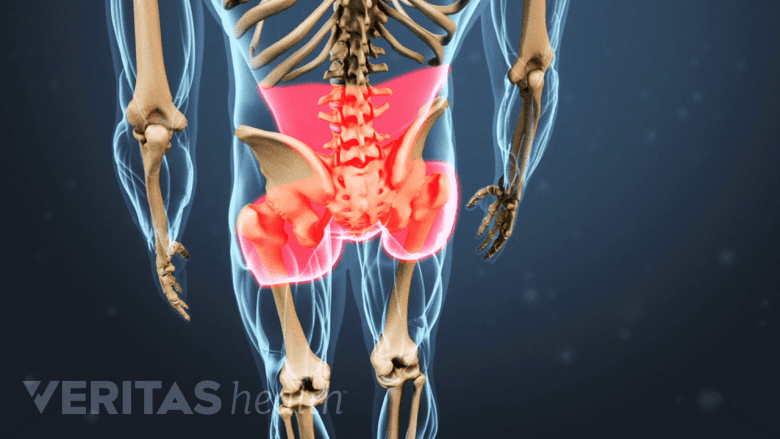Your lower back and hip are codependent structures. A problem in one of these structures can cause dysfunction and pain in the other. 1Reiman MP, Weisbach PC, Glynn PE. The Hip’s Influence on Low Back Pain: A Distal Link to a Proximal Problem. Journal of Sport Rehabilitation. 2009;18(1):24-32. doi:10.1123/jsr.18.1.24
- If you have chronic lower back pain, the movements in your hip may be reduced and the muscles surrounding your hip joint can become tense and painful.2Lee SW, Kim SY. Comparison of chronic low-back pain patients hip range of motion with lumbar instability. J Phys Ther Sci. 2015;27(2):349–351. Available from: https://www.ncbi.nlm.nih.gov/pmc/articles/PMC4339135/,3Lee SW, Kim SY. Effects of hip exercises for chronic low-back pain patients with lumbar instability. J Phys Ther Sci. 2015;27(2):345–348. doi:10.1589/jpts.27.345
- If there’s an abnormality in your hip function, the mechanics of your lower back may be altered, causing pain in both regions.4Harris-Hayes M, Sahrmann SA, Van Dillen LR. Relationship between the hip and low back pain in athletes who participate in rotation-related sports. J Sport Rehabil. 2009;18(1):60–75. doi:10.1123/jsr.18.1.60
The lower back and hip share many groups of muscles. When a specific muscle is affected, it may lead to compensatory movements, fatigue, and pain in the other surrounding muscles.1Reiman MP, Weisbach PC, Glynn PE. The Hip’s Influence on Low Back Pain: A Distal Link to a Proximal Problem. Journal of Sport Rehabilitation. 2009;18(1):24-32. doi:10.1123/jsr.18.1.24
Read on to learn how lower back and hip pain can occur together. While some conditions may affect one side of your lower back and hip, others can cause pain on both sides at the same time.
Sharp pain in the lower back and hip on one side
A shooting and sharp pain felt on one side on your lower back and hip may be caused by muscle spasm, joint dysfunction, and/or nerve compression in the region. Common conditions that cause this type of pain are discussed below.
Piriformis syndrome
Spasm of the piriformis muscle located deep in the buttock may cause 5Hicks BL, Varacallo M. Piriformis Syndrome. [Updated 2019 Dec 16]. In: StatPearls [Internet]. Treasure Island (FL): StatPearls Publishing; 2020 Jan-. Available from: https://www.ncbi.nlm.nih.gov/books/NBK448172/:
- Moderate to severe lower back, hip, and buttock pain
- Referred pain that may extend into the back of the thigh
- Inability to sit for a long time
The pain is typically felt on one side and may be worsened by hip movements, such as when getting out of bed.5Hicks BL, Varacallo M. Piriformis Syndrome. [Updated 2019 Dec 16]. In: StatPearls [Internet]. Treasure Island (FL): StatPearls Publishing; 2020 Jan-. Available from: https://www.ncbi.nlm.nih.gov/books/NBK448172/
Piriformis syndrome is commonly caused by overactivity of the hip rotator muscles (which help rotate the hip inward or laterally) or sitting on hard surfaces for prolonged periods of time. An injury to the buttock may also cause this pain.6Papadopoulos EC, Khan SN. Piriformis syndrome and low back pain: a new classification and review of the literature. Orthopedic Clinics of North America. 2004;35(1):65-71. doi:10.1016/s0030-5898(03)00105-6
Watch Piriformis Syndrome Video
Sacroiliac joint dysfunction
Inflammation within the joint that connects your lower spine to your pelvis, the sacroiliac joint, can cause7Raj MA, Varacallo M. Sacroiliac (SI) Joint Pain. [Updated 2019 May 12]. In: StatPearls [Internet]. Treasure Island (FL): StatPearls Publishing; 2019 Jan-. Available from: https://www.ncbi.nlm.nih.gov/books/NBK470299/:
- A sharp, stabbing pain felt directly over the lower back, hip, and buttock
- Pain that may extend down the back of your thigh, but typically does not extend below the knee
Certain positions or activities may cause your pain to flare up, such as going from standing to sitting, climbing stairs, or lying on the affected side.7Raj MA, Varacallo M. Sacroiliac (SI) Joint Pain. [Updated 2019 May 12]. In: StatPearls [Internet]. Treasure Island (FL): StatPearls Publishing; 2019 Jan-. Available from: https://www.ncbi.nlm.nih.gov/books/NBK470299/
The sacroiliac joint may become a source of lower back, hip, and buttock pain due to arthritis, trauma, or repetitive stress within the joint.7Raj MA, Varacallo M. Sacroiliac (SI) Joint Pain. [Updated 2019 May 12]. In: StatPearls [Internet]. Treasure Island (FL): StatPearls Publishing; 2019 Jan-. Available from: https://www.ncbi.nlm.nih.gov/books/NBK470299/ This joint is also a common source of pain in pregnant women due to hormonal and bodily changes at the time.8Cohen SP, Chen Y, Neufeld NJ. Sacroiliac joint pain: a comprehensive review of epidemiology, diagnosis and treatment. Expert Review of Neurotherapeutics. 2013;13(1):99-116. doi:10.1586/ern.12.148,9Filipec M, Jadanec M, Kostovic-Srzentic M, van der Vaart H, Matijevic R. Incidence, pain, and mobility assessment of pregnant women with sacroiliac dysfunction. International Journal of Gynecology & Obstetrics. 2018;142(3):283-287. doi:10.1002/ijgo.12560
While more common on one side, sacroiliac joint pain can also affect both sides of the lower back and hip.
Read more about Sacroiliac Joint Dysfunction (SI Joint Pain)
The symptoms of piriformis syndrome and sacroiliac joint dysfunction may mimic lumbar radiculopathy, commonly called sciatica.
Pain and stiffness in the lower back and hip
A feeling of stiffness can accompany pain in the lower back and hip. This symptom is typically a protective mechanism of the body to prevent further injury in the area. Stiffness that occurs with pain can be debilitating and reduce function in the back, hip, and leg considerably. Here are a few common conditions that may cause these symptoms to occur together.
Strained hamstrings

The hamstrings are a group of three muscles spanning the back of the thigh.
Tightness in your hamstrings due to a strain injury may alter the biomechanics of your spine.
Tight hamstrings are shorter in length and this change can affect the curvature of the lower part of your spine, disrupting the alignment of the lower back with your hip. A feeling of stiffness in your lower back with or without pain may be experienced.10Jandre Reis FJ, Macedo AR. Influence of Hamstring Tightness in Pelvic, Lumbar and Trunk Range of Motion in Low Back Pain and Asymptomatic Volunteers during Forward Bending. Asian Spine J. 2015;9(4):535–540. Available from: https://www.ncbi.nlm.nih.gov/pmc/articles/PMC4522442/
The stiffness is usually more pronounced when you bend your spine forward. Some people also walk with a stiff leg to avoid bending their hip and knee joints.11Chu SK, Rho ME. Hamstring Injuries in the Athlete: Diagnosis, Treatment, and Return to Play. Curr Sports Med Rep. 2016;15(3):184–190. Available from: https://www.ncbi.nlm.nih.gov/pmc/articles/PMC5003616/
Osteoarthritis of the hip

Hip osteoarthritis pain can radiate into the lower back causing low back pain and stiffness.
Age-related degeneration of the hip joint (hip osteoarthritis) can cause pain in the lower back and stiffness in the hip.
Hip osteoarthritis causes stiffness and a significant decrease in the hip’s range of motion. This change can cause the hip to incline forward, disrupting the curvature of the lower spine. The inward curvature (lordosis) of the lower spine may become more pronounced, sometimes causing the lower spinal discs to bulge or herniate.12Shigeharu Tanaka, Shinsuke Matsumoto, Kengo Fujii, Kotaro Tamari, Shigeru Mitani, Akio Tsubahara. Factors related to low back pain in patients with hip osteoarthritis. BMR. 2015;28(2):409-414. doi:10.3233/BMR-140535,13Rivière C, Lazic S, Dagneaux L, Van Der Straeten C, Cobb J, Muirhead-Allwood S. Spine-hip relations in patients with hip osteoarthritis. EFORT Open Rev. 2018;3(2):39–44. Published 2018 Feb 21.
This condition may over time cause degeneration of the spinal joints too, resulting in a more advanced problem called hip-spine syndrome.
Learn more about Hip Osteoarthritis on Arthritis-health.com
This list is not exhaustive of all possible causes of lower back and hip pain. If you experience pain and/or stiffness in your lower back and hip that does not resolve with self-care and affects your daily activities, talk to your doctor. A doctor can accurately diagnose the cause of your lower back problem and formulate a treatment plan for the underlying condition.
Learn more:
- 1 Reiman MP, Weisbach PC, Glynn PE. The Hip’s Influence on Low Back Pain: A Distal Link to a Proximal Problem. Journal of Sport Rehabilitation. 2009;18(1):24-32. doi:10.1123/jsr.18.1.24
- 2 Lee SW, Kim SY. Comparison of chronic low-back pain patients hip range of motion with lumbar instability. J Phys Ther Sci. 2015;27(2):349–351. Available from: https://www.ncbi.nlm.nih.gov/pmc/articles/PMC4339135/
- 3 Lee SW, Kim SY. Effects of hip exercises for chronic low-back pain patients with lumbar instability. J Phys Ther Sci. 2015;27(2):345–348. doi:10.1589/jpts.27.345
- 4 Harris-Hayes M, Sahrmann SA, Van Dillen LR. Relationship between the hip and low back pain in athletes who participate in rotation-related sports. J Sport Rehabil. 2009;18(1):60–75. doi:10.1123/jsr.18.1.60
- 5 Hicks BL, Varacallo M. Piriformis Syndrome. [Updated 2019 Dec 16]. In: StatPearls [Internet]. Treasure Island (FL): StatPearls Publishing; 2020 Jan-. Available from: https://www.ncbi.nlm.nih.gov/books/NBK448172/
- 6 Papadopoulos EC, Khan SN. Piriformis syndrome and low back pain: a new classification and review of the literature. Orthopedic Clinics of North America. 2004;35(1):65-71. doi:10.1016/s0030-5898(03)00105-6
- 7 Raj MA, Varacallo M. Sacroiliac (SI) Joint Pain. [Updated 2019 May 12]. In: StatPearls [Internet]. Treasure Island (FL): StatPearls Publishing; 2019 Jan-. Available from: https://www.ncbi.nlm.nih.gov/books/NBK470299/
- 8 Cohen SP, Chen Y, Neufeld NJ. Sacroiliac joint pain: a comprehensive review of epidemiology, diagnosis and treatment. Expert Review of Neurotherapeutics. 2013;13(1):99-116. doi:10.1586/ern.12.148
- 9 Filipec M, Jadanec M, Kostovic-Srzentic M, van der Vaart H, Matijevic R. Incidence, pain, and mobility assessment of pregnant women with sacroiliac dysfunction. International Journal of Gynecology & Obstetrics. 2018;142(3):283-287. doi:10.1002/ijgo.12560
- 10 Jandre Reis FJ, Macedo AR. Influence of Hamstring Tightness in Pelvic, Lumbar and Trunk Range of Motion in Low Back Pain and Asymptomatic Volunteers during Forward Bending. Asian Spine J. 2015;9(4):535–540. Available from: https://www.ncbi.nlm.nih.gov/pmc/articles/PMC4522442/
- 11 Chu SK, Rho ME. Hamstring Injuries in the Athlete: Diagnosis, Treatment, and Return to Play. Curr Sports Med Rep. 2016;15(3):184–190. Available from: https://www.ncbi.nlm.nih.gov/pmc/articles/PMC5003616/
- 12 Shigeharu Tanaka, Shinsuke Matsumoto, Kengo Fujii, Kotaro Tamari, Shigeru Mitani, Akio Tsubahara. Factors related to low back pain in patients with hip osteoarthritis. BMR. 2015;28(2):409-414. doi:10.3233/BMR-140535
- 13 Rivière C, Lazic S, Dagneaux L, Van Der Straeten C, Cobb J, Muirhead-Allwood S. Spine-hip relations in patients with hip osteoarthritis. EFORT Open Rev. 2018;3(2):39–44. Published 2018 Feb 21.

